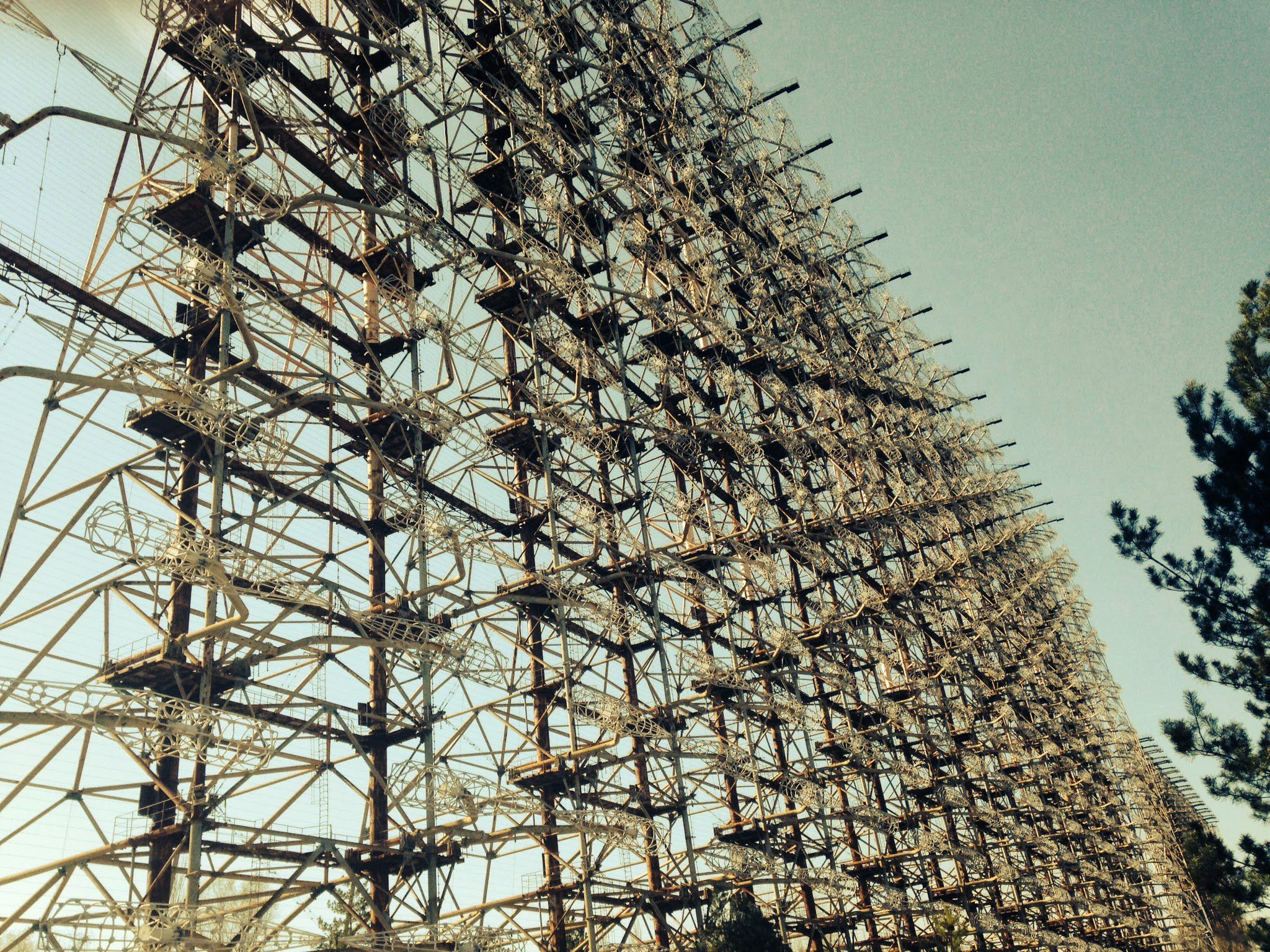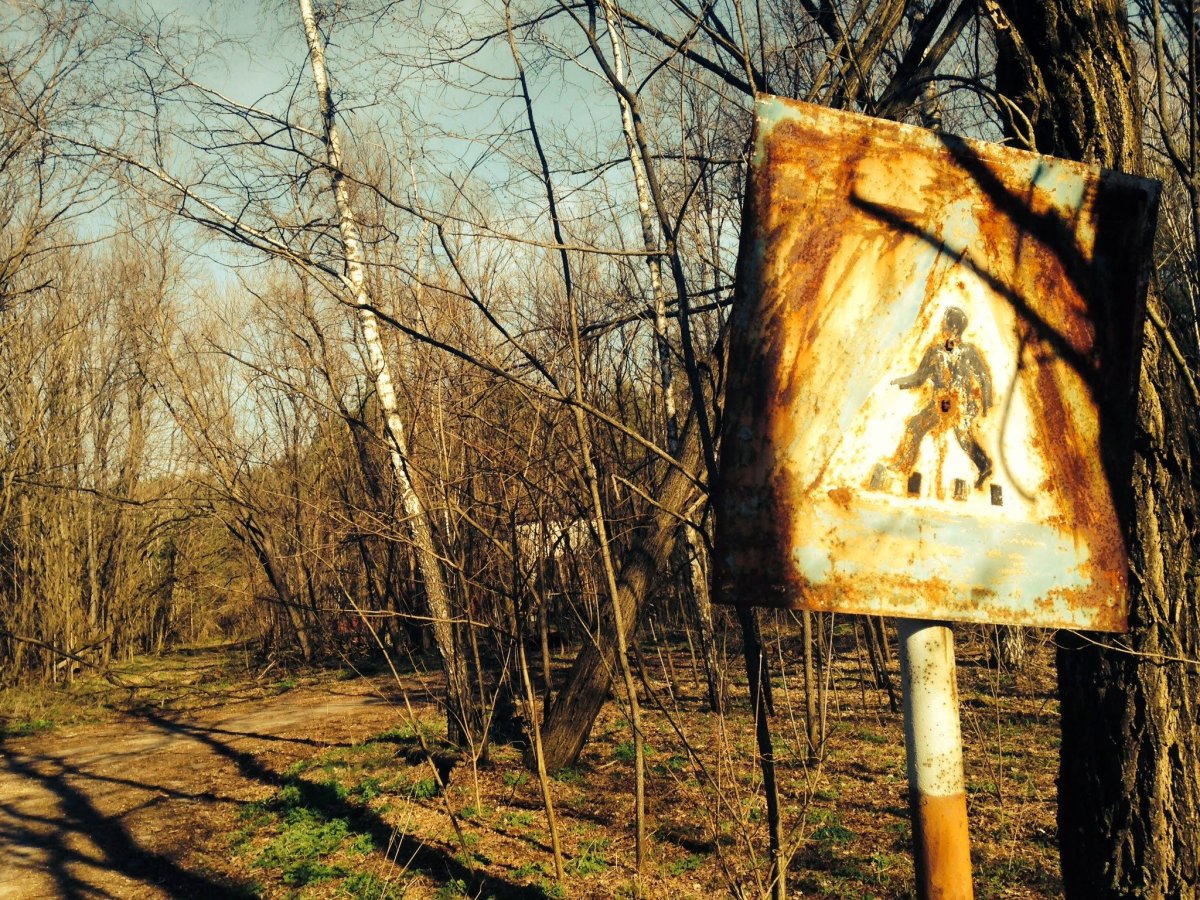
When you are in the middle of the Chernobyl Exclusion Zone, and your tour guide asks, with just a hint of guile, if you would like to see the Russian Woodpecker, you might think that you will finally be afforded a glimpse of one of the area's fabled mutants, an irradiated avian with a beak the size of Finland.
You assent. Yes, let's go see the Russian Woodpecker! How much more strange can things get, really? You then start driving into the woods, on a narrow lane that was once a road: everything in Chernobyl was once something, and something else. A deer skipped along our path. The dosimeter clicked like a summer insect. As Marlow says in Heart of Darkness, "We could have fancied ourselves the first of men taking possession of an accursed inheritance."
There it was, finally, past a guard station and down a lane occluded by weeds: the Russian Woodpecker, the Steel Yard, the Duga-3, a metal mesh that seems to have risen from the Earth intact. Once, it drove Western radio operators mad with its insistent clicks. Now it is inert, silent, useless, a stuffed bird in a glass case. Look at it all you want. Climb it, even, but keep in mind that that's Soviet steel under your feet.
The entirety of what's known as the Chernobyl Exclusion Zone is a sort of matryushka nesting doll encompassing 1,000 square miles. There is the outer 30 km ring, followed by the 10 km ring surrounding the nuclear power plant itself, followed by the infamous Reactor No. 4, the tenebrous innermost doll that few people have entered since the fatal morning of April 26, 1986. Chernobyl 2 is one of the more mysterious patches in this of picked-over graveyard of forgotten villages, abandoned apartment blocks and radioactive forests.
Once a toxic zone rife with radiation, Chernobyl is today a toxic zone rife with radiation and tourists. Of all the things to see here, Chernobyl 2 is the newest and maybe even the strangest, a superlative not easily earned among Chernobyl's innumerable wonders.
Because the radar was used to gather military intelligence, Chernobyl 2 remained closed to visitors long after the Exclusion Zone opened up to tourism in 2002. That only made the place more alluring. In 2011, a presenter for the Kremlin-sponsored channel RT claimed that he had exclusive access to Chernobyl 2. He then ducked through a gap in the fence. The following year, a video appeared on YouTube showing Ukrainian and/or Russian daredevils BASE jumping off the top of the radar installation, which is almost 50 stories high. To do so, they had to spend an entire day hiking some 20 miles through the Exclusion Zone, at one point fording a river in a frighteningly flimsy life raft. "This is the most beautiful man-made object from which we've jumped," one of them declares before plummeting to the ground.

Finally relenting last fall, the Ukrainian administrators of Chernobyl now permit tourists to view what's formally known as the Duga-3 over-the-horizon backscatter radar installation, which went silent in 1989, rendered useless by a concluding Cold War whose victors would need no nukes for a coup de grâce. From a roof in Pripyat (the company town where Chernobyl's workers lived), the Russian Woodpecker is visible in the distance rising well above the tree line, a sight infinitely more intriguing than the low buildings of the power plant. It looks like the last remnant of a ruined battlement, a now-porous wall that once held Mongols at bay.
First sending out its powerful transmission (10 megawatts) in 1976, the Duga-3 was one of three radar installations in the Soviet Union powerful enough to detect an incoming American intercontinental ballistic missile by bouncing a signal off the ionosphere. But the radar's might is precisely what gave it away. In 1982, Dave Finley of The Miami Herald wrote what remains the only serious mainstream media treatment of the Russian Woodpecker, explaining how "the Soviets…have ignored internationally accepted rules about what frequencies can be used by whom and simply transmitted their ultra-high-powered radar signals on any frequency where…conditions were good at the particular time."
While the nuclear reactor remains a nexus of international concern, the Russian Woodpecker stands largely forgotten. Surrounding structures have been conquered by trees, gravity and rust, but it is humongous from afar and humongous from up close, dwarfing the very idea of perspective. As the nuclear engineer James Mahaffey writes in his book Atomic Accidents, "The antenna was 150 meters tall and 500 meters wide, and this masterpiece of mechanical engineering weighs about 14,000 tons." What looks like a wall from a distance is actually a mesh of steel up close. From its surface emanate pairs of cylindrical wings, the "active element" of the antenna. These make the whole thing look like a flight of white butterflies has been caught in gargantuan netting.
A stairway gives almost too-easy access, inviting the visitor to climb the Duga-3. Once the site of so much secrecy and speculation, the place is today essentially lawless. The martial exhortations on the walls of surrounding buildings were once uttered with somber shows of faith, if not quite conviction. Today, you can only read them with irony. It's a fine line, between socialist paradise and postmodern wasteland.
The intrusive Soviet radar, a recording of which can be heard online today, sounds less like a bird than a machine gun. Amateur radio operators in the United States dubbed it the Russian Woodpecker for the maddening, regular taps it emitted. Frustration with the Russian Woodpecker was profound, as Finley explains, and reasonable: "The 'woodpecker' regularly interferes not only with commercial and amateur communications but with international broadcasting stations." In a fit of techno-patriotism, some ham geeks tried to cleanse the airwaves of the Russian Woodpecker by sending out a jamming signal. Their collective effort was dubbed the Russian Woodpecker Hunting Club and was, by most accounts, successful.
There are some people—some very paranoid people—who think Chernobyl 2 was used by the USSR for mind control. Others thought it might merely be controlling the weather, or communicating with submarines. Having grown up in the Soviet Union, I am flattered by these nefarious suggestions. We would have, believe me, if we only could, but it was hard enough to keep the grocer's shelves stocked.
In some ways, the Russian Woodpecker is more symbolic of the Soviet plight than the infamous Reactor No. 4, whose meltdown was catastrophic but also singular. The Russian Woodpecker, on the other hand, is part of a vast flock of Soviet military installations that have simply been allowed to fester in decrepitude: the underground submarine base at Balaklava, Crimea; the Dvina missile silo in Lambarte, Latvia; the abandoned fighter jets at Vozdvizhenka, in the Far East. It's almost like everyone agreed to play an incredibly dangerous game that, after half a century, suddenly seemed pointless and even boring. When it was over, the players dropped their toys and went home.
If anything, the military purpose of Chernobyl 2 is a reminder that the purpose of the Chernobyl power station was never entirely civilian, either. While it did provide vast amounts of electricity to Ukraine, its four reactors were of the RBMK variety, meaning they could be easily switched between the fission of uranium for civilian purposes and the enrichment of plutonium for military ones. That left the top of reactor lightly covered, in order to make the switching of fuel assemblies easier. That's why, when the thing unleashed its fiery belch one April day, a good part of Europe got a dusting of radionuclides.
Much like Pripyat, this was once a small town, though a much smaller and more secretive one than its sibling, where 49,000 people lived. That also makes it, today, more serene than the rest of the Exclusion Zone, a lesser Chernobyl where concerns about cesium-137 and strontium-90 somehow seem less real. They aren't, of course, but as you wander a dilapidated mess hall, you might think you are merely in a relic of the Cold War, not of a nuclear catastrophe from which humanity is still recovering. While Chernobyl 1 still has the power to frighten, Chernobyl 2 is somehow humorous and melancholy and even a little inspiring: All this, for nothing. And yet it stands.
On the floor of one building lies a dusty copy of a "Military Oath," which exhorts its signers to "be loyal to my People, my Soviet Motherland and the Soviet Government." It warns that those who transgress face the opprobrium of the Soviet citizenry. Below that is a space for signatures. It is empty.
First article in this series: Tourism, Construction and an Ongoing Nuclear Crisis at Chernobyl
Uncommon Knowledge
Newsweek is committed to challenging conventional wisdom and finding connections in the search for common ground.
Newsweek is committed to challenging conventional wisdom and finding connections in the search for common ground.
About the writer
Alexander Nazaryan is a senior writer at Newsweek covering national affairs.
To read how Newsweek uses AI as a newsroom tool, Click here.








